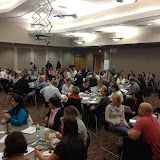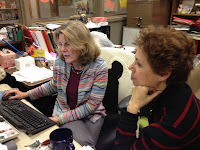Hello Colleagues,
Thank you all for the hard work you put into rubric writing last week. While we received a lot of positive feedback, we also know that this process is not at all easy. As we follow Thursday’s faculty meeting with rubric revision time, it’s important that we maintain perspective on the current task.
When we unanimously passed our statement on Core Values, Beliefs and Learning Expectations, we stated that we want our students to be “active participants in their learning,” by which we mean that we want them to choose resources, set goals, self-monitor, self-assess and reflect. In order to achieve this goal, we need to provide concrete information about our expectations, and that’s where the rubrics come in.
The Process
Now, the process is messy, and where we are right now is near the end of the first stage of a three-stage process:
- Stage one: We draft rubrics.
- Stage two: We use them in pilot form to communicate with students about the work we’re asking them to do, and then ask the students to assess their work using the rubric, while we do the same. From this, we identify the challenges and advantages of using the rubrics to communicate with students and assess student work, and we make recommendations for changes.
- Stage three: We revise the rubrics based on the data collected from the pilot experiment.
A Pressing Concern: Assessment
If there was one overarching concern expressed on our PD Day, it was, “But I can’t see how I’ll use this rubric to assess my students.” If you were one of the ones saying this, you’re probably right.
But this raises misconception number one: that our NEASC rubrics are for assessment. What we are working on are analytical rubrics, not assessment rubrics. While they will be used for assessment, their primary function is to clearly communicate expectations. If we think of them as communication of our learning expectations so that students can be “active participants,” the writing may be a bit easier.
In addition, you may not ever use the problem-solving rubric, for example. But if we can all speak the same language and communicate the same expectations when students are solving problems in our disciplines, you can imagine the effective habits of mind students will develop as they go through all our subjects in ninth grade, in tenth grade…you can see where we’re going. The clearer we are about what we want our students to do, the more quickly they will internalize our school’s standards for their performance.
If you’ve read this far, thank you. If we can understand the stages of the process, our work can be much easier on Thursday.
See you then.
Your Friends on the Steering Committee




